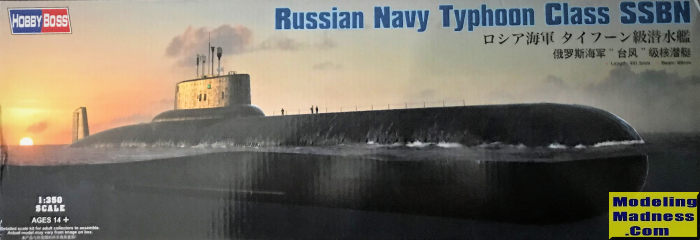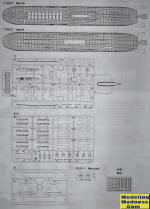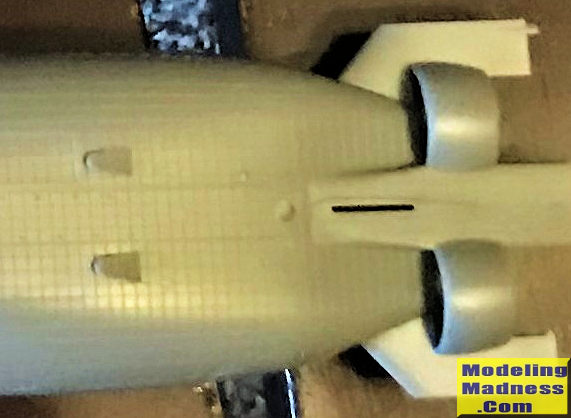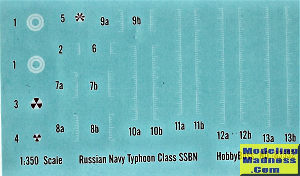
Hobbyboss 1/350 Typhoon SSBN
| KIT #: | 83532 |
| PRICE: | $35-50.00 |
| DECALS: | One option |
| REVIEWER: | Donald Zhou |
| NOTES: | Advantages: Well detailed, simple, some options given Disadvantages: the anechoic tiles on the hull maybe overstated for some and need some serious work in order to display the missile bays open. |

| HISTORY |
The Russian Akula class submarines, or “shark” in Russian (ironically, NATO would name a class of Russian attack subs the “Akula” class, and not this boat) was developed as a direct counter to the American Ohio Class SSBN, or Submarine launched Ballistic missile submarine, Nuclear. Now, even today, an Ohio class is something no one would want to mess with! Equipped with 24 Trident II D-5 sub launched ballistic missiles, each carrying 8 MIRV, or Multiple Independent Re-entry Vehicles (basically, each missile carries 8 nuclear warheads, with a max yield of 455KT. In fact, a Trident can carry even more warheads, up to 14 with a max yield of 100KT but the SALT II treaty limit the missile to only 8 and can guide each warhead independently to eight different targets), a single Ohio can obliterate a small nation if it’s allowed to fire all 24 of its payload! Even though the first four, Ohio, Michigan, Florida, and Georgia have been modified to SSGN, or cruise missile submarines, each with a max payload of up to 144 Tomahawk cruise missiles, the 14 that are still left is still THE premier nuclear deterrent arsenal in the U.S.! Obviously, the Russians needs a response.
And when the first Akula appeared, it was a doozy. At least twice as wide as an Ohio, and taller, the sub, now called Typhoon by NATO is still the world’s largest submarine ever build. Weighting in at a full load of 47,230 tons submerged, it weight almost as much as a WW II battleship. It is designed to carry the R-39 sub launched ballistic missile, NATO code name SS-N-20 Sturgeon, the ship has to be large since the SS-N-20 reportedly has far better range than the Trident I (which forced the U.S. to quickly develop the Trident II) and thus, far larger (during the ‘80’s it was reported the SS-N-20 had as much range as 16,000 KM or 9940 miles, 1300 more than the Trident II). A single Typhoon can carry as much as 20 Sturgeons, each with 9 warheads for a total of 180. Secondary armaments include six 533mm (21inch) torpedo tubes with at least 20 torpedoes stored inside. The sub features a double hull construction (basically two pressure hulls wielded together, with the inner wall removed to form the typhoon hull. Hence the very distinctive oblong shape), another reason why it was so wide and heavy. Basically, as one American officer commented, the Russians basically took two of their Delta II missile subs, slapped them together to form the Typhoon! This also meant it had two nuclear reactors like the Oscar II SSGN. The double hull is then surrounded by the separate outer water hull. This meant the sub would be every hard to sink in combat, capable taking on one or even two torpedo hits and still survive. The most notable thing about the Typhoon is that unlike its former Russian, American and current American counterpart, or even its future replacement, it has all its missiles forward of the “sail”. All the rest of the subs have the missile bays aft of the sails instead, leading to one of its most distinctive, if not the most distinctive feature of the ship.
For years during the ‘80’s, the brinkmanship between the U.S. and Russia was carried out beneath the waves between the Ohios and Typhoons. In fact, the Typhoon became legendary when Tom Clancy (RIP one of my favorite writers) wrote the famous The Hunt for Red October. In it, the Russian had built a modified Typhoon with hydrodynamic drive and equipped with 26 missiles instead of 20. The book went on to be a best seller and modified into a movie (which I both saw and read multiple times). In the book, Tom described the sub a being very austere, with no crew mess and everything devoted to weapons and missiles offering no creature comfort to the crew. Then came the shellshock of 1991 and all of a sudden POOF!!!!! The old USSR went no more. Because of this, it allowed the West to glimpse into Russian technology for the first time. The first shock was the Typhoon wasn’t nearly as prevalent as the Ohios. With its double hull, double redundancy, double reactor and too big of a pole of a missile, the sub was expensive to build and a hell to maintain….Hence one of the reason for the USSR collapse…In fact, only six Typhoons were ever made before Russia ran out of money, compare this to total of 18 Ohios. Hence, why the U.S. decided to agree to limit Ohios to 14 and modified the first 4 to SSGN standards.
The second was the missile. As it turned out, the Sturgeon only had range comparable to the Trident II D-5. The reason why the Russians had always lagged behind the West in some important technologies, computers for ex. and rocket science another. In order to achieve the same range, Russian missiles needed to be bigger due to poorer metal quality and fuel qualities among others. Hence why the Sturgeons were so big and reason why the “Red October” with its 26 missile will never happen! The sub would’ve been way too big for the Russians to afford to build and maintain!
The third is creature comfort…Unlike depicted in the famous book, Typhoon was one of the most lucrative jobs in the Russian Navy! Why? Simple, the food was the best because the sub contains some of the best refrigeration and storage spaces. The personal space for the 164 people onboard were the most spacious among the fleet and the sub even had enough space for an exercise room, a swimming pool and a spa!!!! As any submariners will tell you, space is always at a premium on subs…Not this big fella it seems…And yes, unlike what Tom thought, the sub’s mess is one of the largest in WORLD for a sub! Able to seat every single enlisted men in that room!!
But all of that came at a huge price. As stated, the sub was so hard to maintain that its readiness was already atrocious even in the ‘80’s. When the USSR fell, it hit rock bottom! By 1996 and 1997, two of the sub were already decommissioned. There once was a crazy plan to convert the subs into a submarine oil tanker capable of carrying 10,000 tons of raw oil, under the ice caps to Siberia in the dead of winter….That plans of course fell through due to the costs. One of the sub eventually was used as a test bed for the new Bulava missiles that is now in service on the new Borei class missile subs. In fact, there was a planned to modify at least 4 Typhoons to carry the new missile since the Sturgeons were retired long before the subs. However, After the Russians found out the money it took to modernize a Typhoon could be used to build two Boreis, the plans were shelved. In 2012, the Typhoons were completely replaced by the Boreis. In 2018, plans were underway to begin scrapping two of the Typhoon, closing out a chapter in the history of the Cold War.
| THE KIT |
 Yeah,
over the years, various manufactures tried to release an accurate Typhoon.
Revell were the first to do this and..Its……it’s…Ummm…Yeah….To say it’s not
accurate is to say the least, what with that Gonzo like nose and too short of an
aft. The kit was re-released and offered as the “Red October” after the movie
release but the less said about that kit the better. Then came the Dragon 1/350
release. It’s also released here under Testors (and then Italeri after they
bought out the molds). This is the counter kit to their Ohio Class SSBN.
However, since the kit was produced at the tail end of the Cold War, it’s still
not accurate. The hull shape was too rounded, the tail was a complete crap shoot
but at least it did not have the Gonzo nose! Alanger then also released their
own version but its missing the bridge windows on the sail. Enter Hobbyboss.
Yeah,
over the years, various manufactures tried to release an accurate Typhoon.
Revell were the first to do this and..Its……it’s…Ummm…Yeah….To say it’s not
accurate is to say the least, what with that Gonzo like nose and too short of an
aft. The kit was re-released and offered as the “Red October” after the movie
release but the less said about that kit the better. Then came the Dragon 1/350
release. It’s also released here under Testors (and then Italeri after they
bought out the molds). This is the counter kit to their Ohio Class SSBN.
However, since the kit was produced at the tail end of the Cold War, it’s still
not accurate. The hull shape was too rounded, the tail was a complete crap shoot
but at least it did not have the Gonzo nose! Alanger then also released their
own version but its missing the bridge windows on the sail. Enter Hobbyboss.
Hobbyboss attempt at the Typhoon class was released in 2014. They later also released a 1/700 scale kit for those who don’t have the shelf space. I bought the 1/350 scale one since I always wanted a Typhoon to counter my Ohio on the shelf. Back then, I didn’t have the money necessary for the Dragon kit. Now, I can and it’s a doozy! This is an accurate kit of this sub…Finally.
The first thing after you open the rather large box is the size of this thing. The thing is BIG! Again, it’s at least twice the width of an Ohio and finally, someone got the tail correct! The kit contains 190 pieces. But if you gonna leave out all the missile tubes, it gets cuts down to less than 50. Which is what I’m about to do. Why? Well, this is one of the kit’s major faults. Namely, if you want to display any of the missile bays, then be prepared to scratch build the surroundings. You see, the missile tubes are there but the bay surrounding it is missing! If you just cement the tubes, then there will be empty spaces leading directly into the hull. NOT COOL! How Hobbyboss missed this is beyond me. Hence I will slap some plasticards into the missile openings, and then just cement the doors shut.
 The second
fault for some maybe the anechoic tiles. On all subs these days, special plastic
tiles are attached to the hull to absorb sounds from the inside and also absorb
active sonar “pings” to reduce their range. Now, Typhoons are filled with them
and when they come back from a “cruise”, you can clearly see them. However, when
they are about to go out and after maintenance, you can barely see them so for
some, the anechoic tile detail maybe too much for some. For me though, it should
come down after the preverbal coat of paint.
The second
fault for some maybe the anechoic tiles. On all subs these days, special plastic
tiles are attached to the hull to absorb sounds from the inside and also absorb
active sonar “pings” to reduce their range. Now, Typhoons are filled with them
and when they come back from a “cruise”, you can clearly see them. However, when
they are about to go out and after maintenance, you can barely see them so for
some, the anechoic tile detail maybe too much for some. For me though, it should
come down after the preverbal coat of paint.
Construction begin with attaching the bow planes into the nose. Now, a mechanism similar to those ancient Monogram F-14 kits are there to provide them the ability to swing in and out of their holes. The problem is, at this scale, they are small and look pretty fragile so I’ll glue them in the deployed position and then use plasticard to close the open spaces. Various details are now attached to the bottom hull.
Next is the major step of attaching the bottom hull to the top. If you are going to display the missiles, all 20 tubes, with the missiles are offered. These can be attached to the bottom hull…Again, if you are going down this route, you have to scratch build the tube surroundings. The propellers and rear dive planes are also attached. Judicious use of glue will insure these will be movable later. Now, the propeller themselves are either in plastic or etched brass so you have your options. However, be noted this is not my first time working on these photo etched props. If any previous experience is to go by, the blades are rather fragile so do becareful!
 The rudders
are made next. Again, judicious use of cement will ensure they can move later.
The hatches are made in the next step. If you are going to close everything like
I’m planning, you can skip the inside details. The sail has options. The first
is all closed up as if the sub is underwater. The second is with all the
antennas out, as if it’s underway on the surface so you have your choices. The
kit is finished with the attaching of the forward and aft escape hatches. These
are usually white so they can be easily spotted.
The rudders
are made next. Again, judicious use of cement will ensure they can move later.
The hatches are made in the next step. If you are going to close everything like
I’m planning, you can skip the inside details. The sail has options. The first
is all closed up as if the sub is underwater. The second is with all the
antennas out, as if it’s underway on the surface so you have your choices. The
kit is finished with the attaching of the forward and aft escape hatches. These
are usually white so they can be easily spotted.
| CONCLUSIONS |
This should be a good kit to build with the hatches closed. Again, I always wanted a Typhoon and this sure fits the bill! Sigh, it just will be awhile cause I need to finish some projects first before getting started on it!
February 2020 Copyright ModelingMadness.com If you would like your product reviewed fairly and
fairly quickly, please
contact
the editor or see other details in the
Note to
Contributors. Back to the Main Page
Back to the Review
Index Page
Back to the Previews Index Page